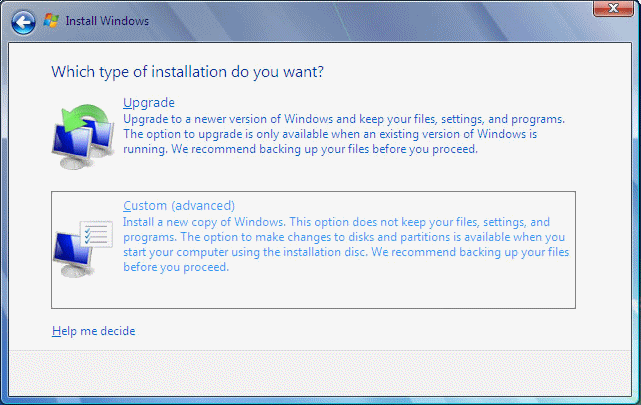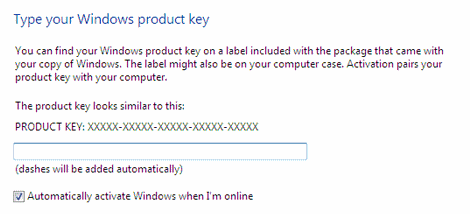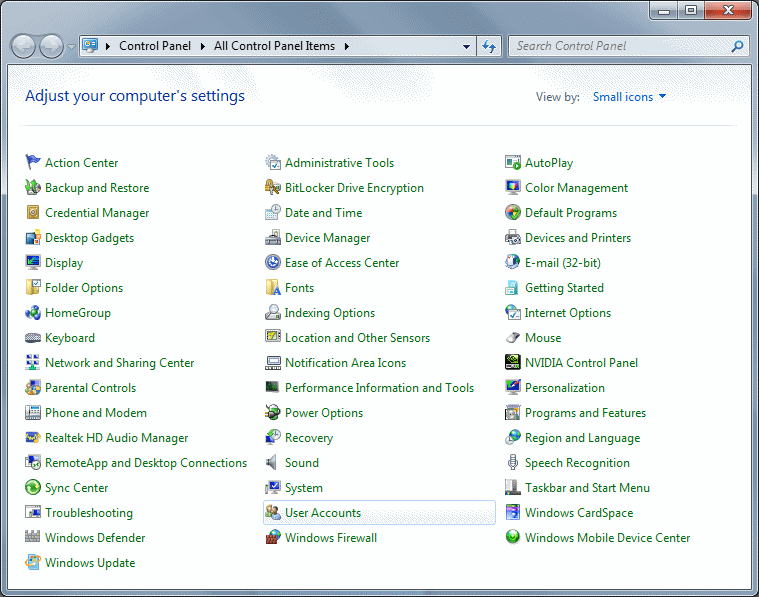
On most new computers Windows 7 is preinstalled. Although in the beginning Windows is free of errors but in time it will become slower, shows errors or perhaps won't boot anymore. If the computer can no longer be used in a decent manner, it is time to reinstall Windows. Although many fear the time it takes to reinstall Windows, if it is planned well it will take less time than expected. For this reason, the 10-steps to reinstall and optimize Windows can be very helpful!
Before starting the reinstall
Before starting the reinstall of Windows 7 it is wise to take some precautionary
measures. For example, if there are still personal files on the hard disk (e.g. personal documents,
pictures,
videos, e-mail, contacts,
login e-mail account settings and visited websites, installed hardware drivers,
...), it is wise to make backups of these files. To prevent problems installing
the
hardware drivers after Windows has been reinstalled, it is wise to disconnect all
peripheral devices (like printers, card readers, external hard disks, ...)
before installing Windows (these can be reconnected after installing Windows
which makes it less difficult to track problems concerning the hardware).
If needed the hard disk can be
repartitioned with partitioning software before installing Windows, but this
can also be done during setup.
Normal installation DVD vs. recovery system
There are two different ways to perform a reinstall: with a Windows install DVD
or with a recovery system prepared by the manufacturer. The Windows install DVD
performs a clean install but has the disadvantage that the hardware drivers and
software must be installed by the user. A recovery system does most of this work
(automatically installing of drivers and software), however the user has little
or no influence on how this is done... Which installation procedure has to be
followed depends on the manufacturer/computer store. If you don't want to be
dependent on a recovery system, it is important to ask for the official Windows
7 install DVD when the computer is bought!
|
|
Using the install DVD of another computer
If the original Windows
7 install DVD is no longer available, there is still the option to use the
install DVD of another computer (to prevent Windows activation issues, make sure
the product key of the concerning computer is used, in most cases this key can
be found on the license label at the back of the computer). Although the
different Windows 7 versions (Home Premium, Professional, Ultimate) can't be
exchanged, there is a workaround to prepare the Windows 7 install DVD to use it
for all Windows versions: create an ISO image of a Windows 7 install DVD (using
a tool like ImgBurn,
download: www.imgburn.com),
remove the file \sources\ei.cfg from the image (using a tool like
7-Zip; download:
www.7-zip.org) and burn the edited ISO image on DVD.
TIP: For realizing a multiboot system, it is necessary to create multiple primary partitions, one for each operating system (in combination with a boot manager). Make sure you created a back-up of your personal data, hide the currently installed operating systems and remove an earlier installed boot manager before starting the setup of Windows 7.
THE RECOVERY SYSTEMAlmost all computers build by the well known manufacturers contain a recovery system. The files for this recovery system are stored on a special recovery partitions (in most cases this partition is hidden but can be found in Windows Disk Management). The recovery procedure can be activated during the startup of the computer and/or by selecting the recovery option in the start menu of Windows. If the recovery partition is no longer available, Windows can be reinstalled by using the recovery DVD. If this DVD is not shipped with the computer it has to be burned by the user (the first time the computer is booted). If this is not an option anymore, the manufacturer can be requested to send the DVD by mail. Because every recovery system works different, it is hard to present an unambiguous manual. Therefore, read the accompanying manual or contact the helpdesk of the computer manufacturer if there are any questions about the recovery system on your computer. |
CHOOSING BETWEEN A 32 OR 64 BIT INSTALLATIONWindows 7 can be installed in both 32 bit and 64 bit (go to control panel, sub System to verify which version is installed). The 64 bit version can be installed on each computer with a 64 bits processor. Although the 64 bits version has some advantages (in most cases it is faster and able to handle more than 3 Gb of RAM memory) it is not always the most obvious choice. For many programs and hardware drivers there isn't (yet) a 64 bit version available. Only choose for the 64 bit version if there is 4 Gb of RAM and you are sure 64 bits drivers are available for your hardware and your software works error free. At this moment most computers are installed with the 64 bits version, the number of 64 bits drivers and programs will grow quickly (the 32 bits version of files can be recognized by x86 and the 64 bits version by x64). Attention: the older 16 bit software can't be used anymore in the 64 bit version! In Windows 7 Professional and Windows 7 Ultimate older software can be started using the Windows XP modus! |
SETUP FROM USB STICKIf needed (e.g. in case of a notebook without a DVD player) Windows 7 can be installed from an USB stick (or other types of flash memory with a capacity of at least 3 Gb) as well. The USB stick must be made bootable for this purpose on a computer with Windows Vista or Windows 7. Connect the USB stick, start the Command prompt (start menu, All programs, Accessories), enter the command DISKPART and a new window opens. Enter the command LIST DISK to show a list of detected memory devices. Find out the number of the connected USB stick in the shown list and enter the command SELECT DISK <disknumber> (replace <disknumber> by the found number). The next step is to format the USB stick with the following commands: CLEAN Now the USB stick has been formatted properly, all files on the Windows 7 install DVD can be copied to the USB stick using the Windows Explorer. After all files have been copied, the USB stick is ready to be used for installing Windows 7. At last, make sure the computer is able to boot from USB media by changing the boot order in the BIOS. TIP: The tool Windows 7 USB/DVD Download Tool (download: www.download.com/Windows-7-USB-DVD-Download-Tool/3000-18513_4-10972600.html) can be used as well for creating a bootable USB stick based on an official ISO file of the Windows 7-DVD! |
The setup procedure of Windows 7 is easy. Although the setup can be started within Windows, it is better to do a clean install by booting the computer directly from the Windows DVD. As soon as the startup procedure has detected the DVD, the user is asked for confirmation to boot from the Windows 7 DVD. In one of the following steps you have to choose between the two types of installation: an upgrade and a custom (advanced) installation.
Upgrade or custom installation
An
upgrade installation performs an upgrade of the currently installed Windows.
This results in a reinstall of Windows without formatting the partition: if
possible settings, personal files and installed programs are transferred to the
new installation. Although this sounds attractive,
problems out of the previous Windows install can be imported as well. That's one of the reasons why a clean
installation is preferred above an upgrade installation, therefore rather choose
for the custom installation procedure where the hard disk can be
repartitioned and/or the system partition
formatted
(before proceeding make sure there is a
backup of the personal files!).

Selecting a partition
During setup the user is asked which partition to install Windows 7 on. If there
are no partitions yet (or if the current partitions have to be deleted) the hard
disk has to be partitioned
first. This can be done with partitioning software before the setup starts, but
can be done during setup as well by the link Drive options (advanced) at
the moment the user is asked on which partition to install Windows. If the setup
assigns a disk letter other than C:, abort the setup and try again. This behavior happens after
Windows is installed on a non-partitioned hard disk where the DVD player has
been assigned the disk letter C: first. Restarting the setup is important to
make sure Windows is installed on a C: partition.
ATTENTION: If Windows is installed on a partition which already contains a Windows Vista/Windows 7 installation (without formatting) then programs, settings and personal data will be transferred automatically to the new operating system while the old system files will be moved to the folder Windows.old. In case this back-up is not desired, repartition and/or format the hard disk!
WHAT IF THE COMPUTER DOESN'T BOOT FROM DVD...If the computer doesn't boot from the Windows 7 DVD, the boot order has to be changed in the BIOS (in most cases the DEL or F2 key must be pressed while booting the computer, to get access to the BIOS). Look for something like boot order or boot sequence. Change the boot order and make sure the DVD player will be the first boot device (before the hard disk does). If the setup has finished, the boot order can be restored to the previous settings. |
WHAT IF THE HARD DISK IS NOT RECOGNIZED?During the setup procedure, you are asked on which partition to install Windows 7. If there is no partition to choose from, possibly the hard disk is not recognized by Windows. The most common cause is a SATA controller or RAID configuration (a combination of two or more hard disks working together to achieve a faster and/or more reliable system) which isn’t supported by Windows yet. This problem can be solved by loading the missing drivers (at the moment when is asked for which partition to install Windows on) with the option Load Driver from disk, CD or USB memory stick. The hardware drivers needed for the controller are stored on the CD with drivers and software for the motherboard. For better support, download the newest drivers from the website of the motherboard manufacturer (see the page about installing hardware drivers). TIP: Some motherboards have a feature to load a SATA hard disk as an IDE hard disk. Search the BIOS settings for an option like Native SATA support/AHCI (Advanced Host Controller Interface), and disable it. Although this setting works fine, it is better to install the original drivers for the SATA controller afterwards followed by restoring this setting. |
SYSTEM RESERVED PARTITIONBoth Windows 7 Professional and Windows 7 Ultimate create a 100 Mb hidden primary partition called SYSTEM RESERVED, besides the partition for the Windows installation. This partition is used for BitLocker (to enable encryption of the Windows partition) and contains the Windows Recovery Environment (WinRE) as well. Bitlocker is not used by many en the recovery console can be started from the Windows DVD as well. Therefore the system reserved partition is needless in most cases. However, there is no option to prevent the creation of the system reserved partition during setup. If you don't want the system reserved partition there are two options: partition the hard disk before starting the setup or reformat the currently available primary partition during setup (without repartitioning). There is a workaround as well to get rid of the system reserved partition during setup: delete the created Windows partition, add the free space to the 100 Mb system reserved partition, format the system reserved partition and install Windows on the enlarged partition. |
Creating a new user account
After the computer is restarted, you are asked for a name for the user
account and the name for the computer (only use short names without spaces). The
next screen can be used to enter a password for the user account (although it is
advised to enter a password, it is not necessary). When the computer is used by
multiple users it is wise to create multiple user accounts after the setup has
been finished (visit the page about
setting up a user account for
more information).
The product key
In the next step the user is asked for the product key, however it is not needed
to specify the key. The option Automatically activate Windows when I'm online
is enabled by default but can be deactivated when immediate activation is not
desired (useful when one doubts whether the hardware is compatible, in that
case the product key can still be used on another computer).

Home network,
Work network or Public network
After the window with the date and time settings has been confirmed, the user is
asked what network the computer is connected to: a home network, a work network
or a public network. Depending on the type of network files and/or printers are
shared with other computers in the network. If the computer is in a home or work situation,
Home network or Work network would be
the most obvious options to choose. However, if the advantages of a network like
sharing files and printers are not used at all, choosing for Public network as location
type is
probably the best option to choose because this results in a better secured
computer. The selected option can be changed afterwards within the
Network and Sharing Centre.
HomeGroup
If Home network is chosen as location type the next window asks the user
which personal files must be added to the HomeGroup. The HomeGroup is
secured with a user account independent password and can be filled with files (e.g.
personal documents, pictures, music and videos) which can be accessed by another
computer in the network. Skip creating a HomeGroup if there is no need to
share the files
with other computers!
WORKAROUND FOR THE LIMITATIONS OF A W7 UPGRADE-DVDDuring the upgrade procedure with the Windows 7 Upgrade DVD the setup searches automatically for an activated and validated Windows installation (this is not the case for the Express Upgrade-DVD). A 'clean' install cannot be done with the Windows 7 Upgrade DVD following the standard procedure of a normal Windows 7 DVD! Before you can proceed the Windows 7 upgrade procedure there must be an installed, activated and validated Windows. Start the setup from an already installed Windows and choose Custom setup (instead of an Upgrade setup) to achieve a clean installation of Windows 7. The files of the old installation will be stored in the folder Windows.old which can be deleted afterwards by using Disk Cleanup. |
DELAYING THE WINDOWS 7 ACTIVATION FOR 4 MONTHSWithout product activation, Windows 7 can be used for 30 days, after this period the operating system switches to a modus with reduced functionality (RFM). The command SLMGR -rearm makes it possible to extend this period three times with 30 days. To achieve this, run the Command Prompt (Start menu, All Programs, Accessories) in administrator modus by right clicking on the shortcut and choosing for Run as administrator. Following this procedure, the allowed period can be maximized to four months. The command SLMGR shows the other options of the Windows Software Licensing Management Tool, like changing/removing the current product key and showing the current licence information. |
Now Windows is installed, it is time to change some settings concerning the Windows Explorer and the Control Panel. According to the default settings the different items are shown by categories. The commands on this website assume that the control panel is showing all options by setting the view to big or small icons instead of categories.

The system files are hidden by default, which is fine for less experienced users. However, some of the changes mentioned on this website assume that both system and hidden files are made visible. This is done by changing the following settings on the tab View (available through the button Organize of the Windows Explorer, Folder and Search Options, see the page optimized Windows 7 settings as well):
ATTENTION: Unhiding files isn't always practical for daily use. If needed hide them after you are finished.
© 2001-2022 - Menno Schoone - SchoonePC - Rotterdam - The Netherlands